#zahrtmann school
Text
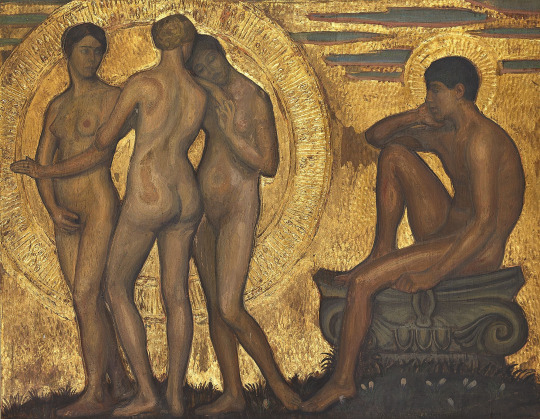
Johannes Kragh (May 9, 1870 - 1946) was a Danish painter, sculptor and mosaic artist. He trained as a craftsman before visiting the Academy and Zahrtmann and Krøyer's school. His art was mainly held in Jugendstil with ample use of gold.
Above: Judgment of Paris, 1928 - oils and gold on panel (Privately owned)
#art#danish artist#johannes kragh#danish royal academy of fine arts#zahrtmann school#mosaic#gold leaf#oil on panel#judgment of paris#mythological art#jugendstil#skønvirke#1920s
21 notes
·
View notes
Photo
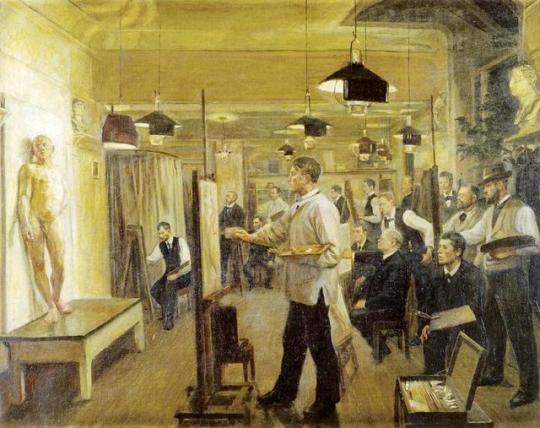
Zahrtmann's Masters School (c.1899). Poul S Christiansen (Danish, 1855-1933). Oil on canvas. ARoS Aarhus Kunstmuseum.
Christiansen studied art at Zahrtmann's Artists Studio School (1885-1890). He travelled to Italy on several occasions and stayed with Zahrtmann in Civita d'Antino. He was considered by the Funen Painters to be one of their own when they exhibited his works at the Faaborg Museum. Christiansen met considerable opposition and it was only with Zahrtmann's support that he was able to exhibit at Den Frie Udstilling in 1895.
25 notes
·
View notes
Photo

Poul S. Christiansen, Zahrtmann’s Masters School, c.1899
16 notes
·
View notes
Photo

NICOLAI WILHELM MARSTRAND
On this day of 24th December, Nicolai Wilhelm Marstrand (24 December 1810 – 25 March 1873), was born in Copenhagen, Denmark.
He was a painter and illustrator who is one of the most renowned artists belonging to the Golden Age of Danish Painting.
Marstrand studied at Copenhagen's Metropolitan School (Metropolitanskolen), but as he had little interest in books he got admitted to the Royal Danish Academy of Art (Det Kongelige Danske Kunstakademi) in Copenhagen.
Although his interests had a firm hold in genre themes – depiction of the daily life he observed around him in Copenhagen's streets, especially middle-class society – he would soon reach for the pinnacle of Academic acceptability: the history painting.
Christian Waagepetersen, a wine merchant to the Danish court and supporter of the arts also became an important patron.
Despite an unmistakably growing recognition, Marstrand never received the Academy's gold medal.
Gold medal or not, however, the Academy did award Marstrand a travel stipend. He travelled to Berlin, Dresden, Nuremberg, Munich, Rome, Olevano Romano, Civitella, and Subiaco. He was enchanted with the ways of life of the Italian people. He portrayed a colorful, joyous, and romantic view of them, infused with a newfound ideal of beauty.
He also painted a number of portraits during this first stay in Italy. Among these are portraits of other travelling artists, such as Christen Købke, Johan Adolph Kittendorff. He completed sketches for a botanist and politician, J. F. Schouw, which would be later realized as a painting.
He became a member of the Art Academy, after submitting the painting "Erasmus Montanus" as his admissions piece and became a professor at the Academy. He endeavored to let his students evolve according to their own skills and interests. Among them were Peder Severin Krøyer, Michael Ancher, Carl Bloch, and Kristian Zahrtmann.
Marstrand was named Director (Chancellor) of the Art Academy and was awarded the rank of State Councillor (etatsråd).
Marstrand was struck with a brain hemorrhage and was partially paralysed, losing much of his work capacity before his death.
#nicolai wilhelm marstrand#famous artists#master painters#art history#anniversary of artists#golden age of danish painting
0 notes
Text
Scenes from Scandinavia go on show

Paintings by renowned landscape artist Harald Sohlberg are set to go on display at Dulwich Picture Gallery in February, in the first exhibition of his work outside of his native Norway.
Sohlberg was born in Kristiania (modern-day Oslo) in 1869 and originally trained as a decorative painter before attending the art school of Kristian Zahrtmann in Copenhagen, where he encountered the work of Paul Gauguin and other symbolist and synthetist artists.
The exhibition will begin with two accomplished self-portraits and will consider Sohlberg’s identity and early development; in particular, how he found his subject in the Norwegian landscape.
It will be arranged chronologically, tracing the breadth of Sohlberg’s artistic career, from his earliest production as a 20 year old in 1889 through to the last year of his life, and will reveal influences such as Norwegian naturalism and neo-romanticism.
His most accomplished works including the atmospheric Fisherman’s Cottage (1906) will be showcased, along with what is arguably his most ambitious work, Winter Night in the Mountains (1914), which is considered to be the “national painting of Norway”.
The exhibition will also highlight the significance and emergence of colour in his work, as well as the influence of Symbolist art and thinking, particularly in his exploration of the popular and mysterious 19th century theme of the mermaid.
Visitors will also be introduced to his celebration of rural landscapes of Norway, providing a snapshot of his time. Works such as Summer Night (1899) and Sun Gleam (1894) reveal his interest in alluding to the human narrative in his paintings, despite the absence of any figures.
Although Sohlberg studied and travelled abroad, it was in the villages and nature of Norway that he truly found his voice. The exhibition will give particular focus to his paintings in and around the small mining town of Røros – now a UNESCO World Heritage site that sits high in the mountain plans of central Norway.
Sohlberg lived there with his wife from 1902-5 and the town’s colourful wooden houses – in stark contrast to the bright, white snow – inspired a large body of his paintings including Street in Røros in Winter (1903).
The exhibition will culminate with a room dedicated to Sohlberg’s time in the Rondane mountains. His most famous work, Winter Night in the Mountains, finished in 1914, takes centre stage.
It took 14 years to complete, and several studies on display will offer a rare insight into his creative process, revealing his near life-long obsession with the subject and the physical extremes of his approach to painting.
The exhibition is guest curated by Kathleen Soriano, independent curator, author, broadcaster, and expert judge of Sky Arts ‘Artist of the Year’. Speaking of the exhibition, she said:
“Harald Sohlberg’s acutely observed Norwegian landscapes will bring intense colour and drama, as well as mood and symbolism to Dulwich Picture Gallery. Celebrating the distinctive style of his painting, the exhibition champions this artist whose work captures both a sense of the everyday and an elegiac, mystical spirituality.”
Jennifer Scott, The Sackler Director of Dulwich Picture Gallery, said: “What better way to start the New Year than with a touch of Scandinavian enchantment? We’re bringing Norway to London, through Sohlberg’s sun-drenched fjords, moonlit mountains, and picturesque towns blanketed in snow.
“This unprecedented opportunity to enjoy Sohlberg’s greatest works together means that audiences in the UK can discover Norway’s best-loved artist and - until now - their best-kept secret.”
The exhibition will also feature a newly commissioned installation at Dulwich Picture Gallery by German-born, Bristol-based artist Mariele Neudecker. Breathing Yellow: And then the World Changed Colour is inspired by the Norwegian landscape and Sohlberg’s work.
......................
Harald Sohlberg: Painting Norway is on show at Dulwich Picture Gallery from February 13 to June 2.
Pictured: Harald Sohlberg, Self-Portrait, 1896, Private Collection.
1 note
·
View note
Text

Poul Corona (née Kronemann) (June 25, 1872 - 1945) was a Danish painter, poet and musician. He came from a traveling circus family, but attended but the Royal Academy and the Zahrtmann School, before establishing himself in Oslo, Norway.
Above: Parti fra Skagen, 1911 - oil on canvas (Privately owned)
#art#danish artist#danish painter#landscape painting#poul corona#danish royal academy of fine arts#oil on canvas#zahrtmann school#skagen#1910s
12 notes
·
View notes
Text

Ludvig Find (May 16, 1869 - 1945) was a Danish Modernist painter who did some of his best work while still a student - first a couple of years at the Academy, then much longer with Krøyer and Zahrtmann. His work was Symbolist at the time with lines back to the Renaissance. Later he became much more traditional in his art.
Above: The New Hat, 1907 - oil on canvas (Loeb's Danish Art Collection)
#art#danish artist#ludvig find#modernist art#danish painter#oil on canvas#genre painting#symbolist art#danish royal academy of fine arts#zahrtmann school#loeb's danish art collection#1900s
12 notes
·
View notes
Text
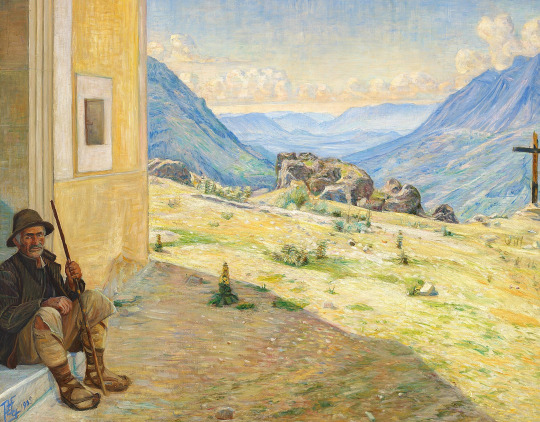
Poul S. Christiansen (Oct. 20, 1855 - 1933) was a Danish artist and illustrator, trained at the Zahrtmann School of Painting where he stayed on for 20 years as Kristian Zahrtmann’s right hand man.
Success came hard for Christiansen, but after some successful Dante paintings, he became more accepted, esp. as a portrait painter. He often traveled with Zahrtmann to Cività d'Antino where he found appealing landscape scenes, too.
Above: Sydeuropæisk bjerglandskab med hyrde i forgrunden, 1905 - oil on canvas (sold by Bruun Rasmussen for Dkr. 18.000 in 2004)
#art#danish painter#danish artist#landscape painting#oil on canvas#poul s. christiansen#1900s#cività d'antino#zahrtmann school
5 notes
·
View notes
Text

Stephan Ussing (June 16, 1868 - 1958) was a Danish regional artist who kept returning to the city of Ribe where his family came from. Ussing had studied at the Royal Academy under Vermehren, Exner and Bache, and had also attended Zahrtmann’s school and Académie Julian in Paris.
Above: Parti fra Ribe, 1929 - oil on canvas (Ribe Kunstmuseum)
#art#danish painter#landscape painting#danish royal academy of fine arts#oil on canvas#stephan ussing#ribe kunstmuseum#académie julian#zahrtmann school
7 notes
·
View notes
Text

Karl Schou (March 9, 1870 - 1938) was a Danish landscape painter, trained at Zahrtmann’s school. He usually painted in small formats with a restrained palette, but occasionally he did epic murals, for instance for Rigshospitalet in Copenhagen. His motto was “To paint is to be quiet.”
He is represented well in Danish museums, and also in the Norwegian National Gallery where this canvas is taken from:
Toget kommer, 1916 - oil on canvas
#art#danish painter#karl schou#1910s#oil on canvas#landscape painting#zahrtmann school#rigshospitalet#nasjonalmuseet
8 notes
·
View notes
Text
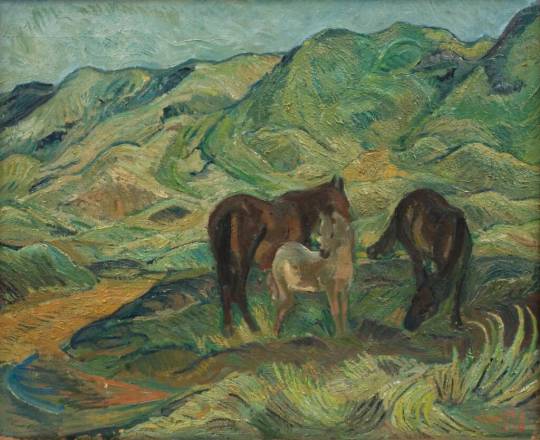
Axel P. Jensen (Sept. 28, 1885 - 1972) was a Danish landscape painter. A friend and student of Zahrtmann and Johan Rohde, he devoted himself to an enhanced, colorist type of naturalism and was very popular and highly regarded in his day…
Above: Landskab med Heste, 1919 - oil on canvas (SMK)
#art#danish painter#axel p jensen#danish artist#landscape painting#smk#smkmuseum#statens museum for kunst#zahrtmann school#johan rohde#kunstnernes frie studieskoler#1910s#grønningen#horses#naturalism#colorist painting#oil on canvas
3 notes
·
View notes
Text

J.C. Schlichtkrull (Feb. 28, 1866 - 1945) was a Danish painter, trained at the Academy and after that with P.S. Krøyer at Zahrtmann’s school. Schlichtkrull liked Vendsyssel and painted many landscapes and portraits of locals from the region. He also traveled abroad, to France and Italy.
Above: Bretagnekoner, der vasker tøj i åens udløb i havet, 1899 - oil on canvas (Privately owned)
#art#danish painter#j.c. schlichtkrull#1890s#oil on canvas#landscape painting#danish royal academy of fine arts#p.s. krøyer#zahrtmann school#brittany#vendsyssel#beach scene
8 notes
·
View notes
Text
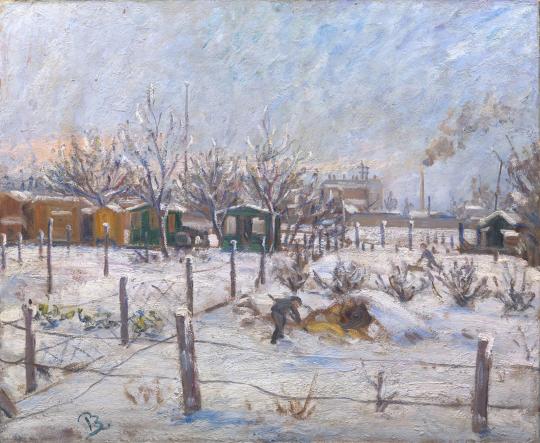
Peter Rostrup Bøyesen (Jan. 16, 1882 - 1952) was a Danish post-impressionist artist, trained mainly at Zahrtmann's school, but also briefly at the Academy. He depicted the changing city and landscape of Copenhagen, and its population, and became increasingly socially conscious.
Here is a canvas from SMK:
Vinter på Nørrebro, 1913-14 - oil on canvas
#art#danish painter#peter rostrup bøyesen#1910s#zahrtmann school#danish royal academy of fine arts#nørrebro#smkmuseum#smk#statens museum for kunst#oil on canvas#landscape painting
7 notes
·
View notes
Text

Fritz Syberg (July 28, 1862 - 1939) was a Danish painter associated with the Funen Painters, many of whom had studied at the Zahrtmann School (the rival school opposing the Royal Academy at the time). Syberg attended the Academy for a short while but then skipped over to Zahrtmann as one of his earliest acolytes and became much more of a colorist under his tutelage…
Above: Over Kærby Bakke, Vinter, 1917 - oil on canvas (SMK)
#art#danish painter#fritz syberg#1910s#landscape painting#danish royal academy of fine arts#smk#smkmuseum#oil on canvas#zahrtmann school#statens museum for kunst#winter landscape#kærby bakke#funen painters
2 notes
·
View notes
Text
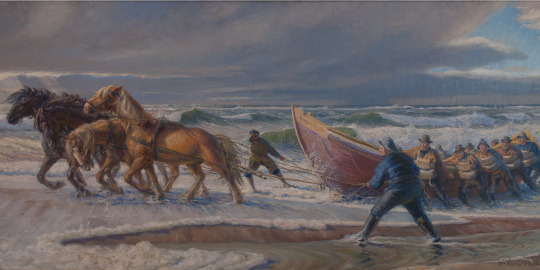
Oscar Matthiesen (July 8, 1861 - 1957) was a Danish painter, trained at the Academy (graduated with gold medal honors) and with P.S. Krøyer and Zahrtmann.
Matthiesen esp. enjoyed working in large formats, whether for religious pieces or secular topics:
Redningsbåd trækkes på land, 1914 - oil on canvas (Nymindegab Museum)
#art#danish artist#danish painter#landscape painting#danish royal academy of fine arts#oil on canvas#oscar matthiesen#1910s#beach scene#life boat#p.s. krøyer#zahrtmann school
3 notes
·
View notes
Text

Gustaf Wolmar (July 5, 1880 - 1971) was a Swedish-born painter who studied in Denmark (at the Zahrtmann School) and worked there most of his life. He is well-represented at the National Gallery - SMK...
Above: Blomsterbillede. Orkideer fra Haveselskabet, 1931 - oil on canvas (SMK)
#art#swedish artist#zahrtmann school#gustaf wolmar#johan rohde#1930s#smkmuseum#smk#statens museum for kunst#flower painting#oil on canvas
3 notes
·
View notes